


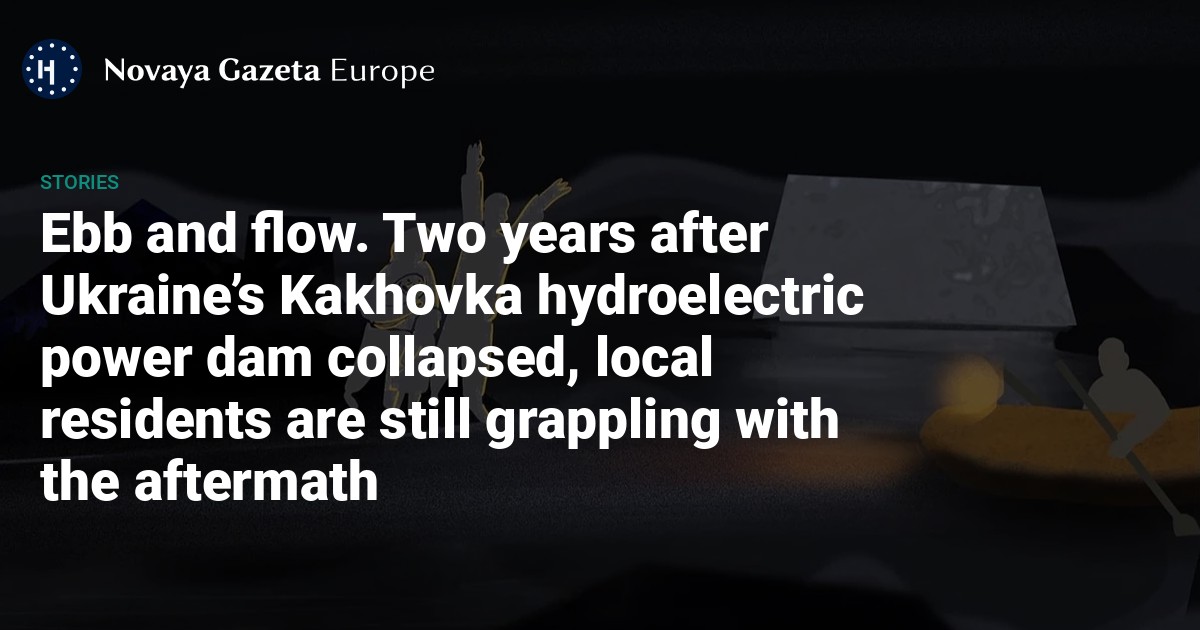
Early in the morning on 6 June 2023, the Kakhovka dam collapsed, destroying thousands of homes in the Kherson region. The death toll is still unknown. Novaya Gazeta Europe checked in with local residents who have spoken to us in the past about how the flood and the constant shelling continue to shape daily life.
Serhiy, 37, occupied Hola Prystan
First the war shattered my life. Then the flood completely destroyed it. For the past two years, I’ve just been going through the motions. It feels like they killed me, but I forgot to die. I often have nightmares about that night. My neighbours were killed. My family could’ve died. It was really scary when the water reached our attic. I sat there with my wife and two children. I got out onto the roof and started yelling, calling for help. In the darkness, a local man paddled by in a boat, steering between rooftops sticking out of the floodwater. He heard me. We escaped with only one bag that held our documents.
We passed by others just as desperate as we were heading towards higher ground. Once we reached dry land, my family got off the boat and we went back to rescue those calling for help. I didn’t feel tired. I only felt the fear and adrenaline pushing me to keep paddling and rescuing people who were stranded on their roofs.
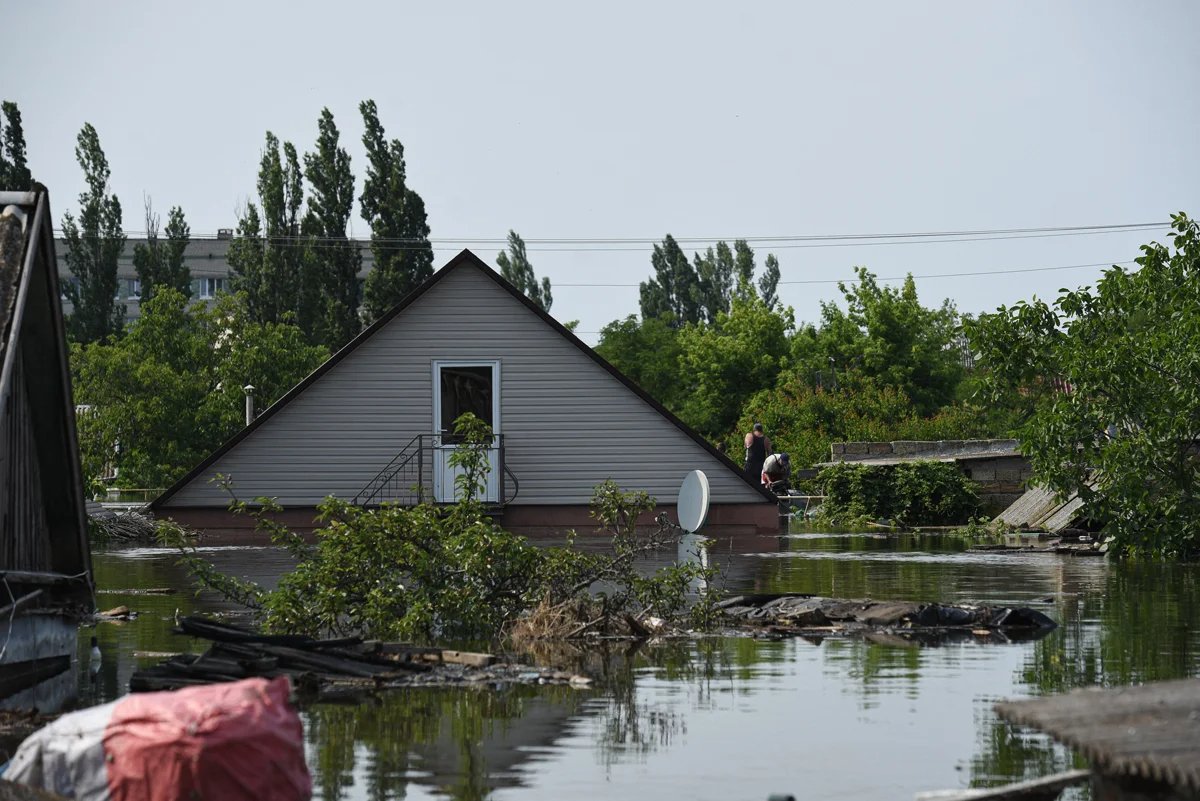
Flooded homes in Hola Prystan, Kherson region, Ukraine, 8 June 2023. Photo: Anadolu Agency / Abaca Press / ddp images / Vida Press
Once I got back to my family, we walked down the street, knocking on doors and asking if someone could take us in, even just for a short period of time. We were allowed to stay in a house that was left empty when the owners went abroad at the start of the war. After resting a bit, I went back out to help evacuate more people.
We spent a month in that house until the owner asked us to move out so one of his relatives could live there. We moved into another empty house. A month later, that first house was shelled and the walls collapsed. Sadly, the neighbours were badly injured and a few were even killed. The shelling continued to get worse and we decided that my wife and kids should go somewhere safer. They left for Skadovsk before moving to Europe. My health problems mean I can’t travel far.
Hola Prystan is under constant shelling and the death toll continues to grow. I’m always on high alert. It’s turned into a ghost town. The parts that were flooded are now overgrown with trees and tall grass. Many of the streets are completely abandoned. Very few people have stayed. It’s mostly the elderly. It won’t be old age that gets them.
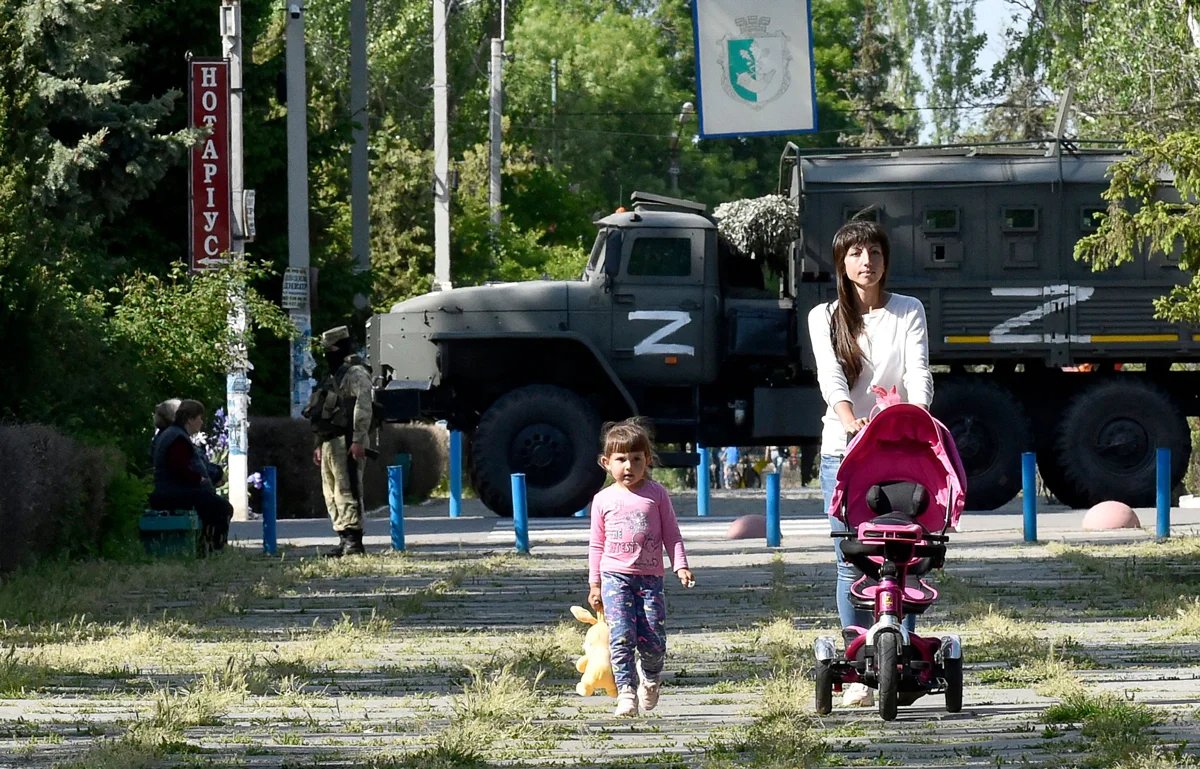
A woman and child pass Russian soldiers in Skadovsk, Zaporizhzhia region, Ukraine, 20 May 2022. Photo: Olga Maltseva / AFP / Scanpix / LETA
Nadezhda, 76, Kherson
We get shelled every day. My neighbourhood is one the hardest hit in the city. After my apartment was flooded, I had to move to a house in the centre. There’s heavy shelling in both areas. I really hoped for a ceasefire, but it never happened — not even for a day. The situation is only getting worse. There are constant drone strikes.
I’ve become a bit hard of hearing since I had a stroke. Recently, when I was hanging up laundry outside, I saw my neighbour waving her hands from her window, yelling for me to run inside. I didn’t understand what was happening at first, but I ran in as quickly as I could. Turns out there was a drone hovering above me.
One play, about a woman who survived the occupation of Kherson and the flood, made me cry. ... Everyone could see themselves in the protagonist.
My only escape is going to the theatre. Now they stage plays in a small bomb shelter. It’s a total of 6,230 steps along a street that’s often attacked. It’s scary, but I still go. I mean, what kind of life is that, staying locked inside? The performances depict our daily reality. One play, about a woman who survived the occupation of Kherson and the flood, made me cry. And I wasn’t the only one. The whole audience was crying. Everyone could see themselves in the protagonist.
I’ve worked as a teacher for a few decades, but classes are all online now. Even if the war ended tomorrow, it’s unlikely that we would be in-person during the next school year. Most of the schools in Kherson have been destroyed. But assuming they’ll be rebuilt, who would study or teach there? Most of the people I know from Kherson don’t want to come back to Ukraine. It’ll be hard to bring back workers. It’ll take years.
Prices have gone up quite a bit in the last six months, around 30-50%. Those classified as “flood victims” receive humanitarian aid, but I don’t get anything. They told me it’s because I didn’t move far enough to be eligible for assistance. But I wasn’t able to move further because I’d have to pay rent. Here I’m able to stay in my parents’ old home. My flat isn’t fit to live in anymore. I’m not sure I’ll live to see the day I can return to my beloved apartment.
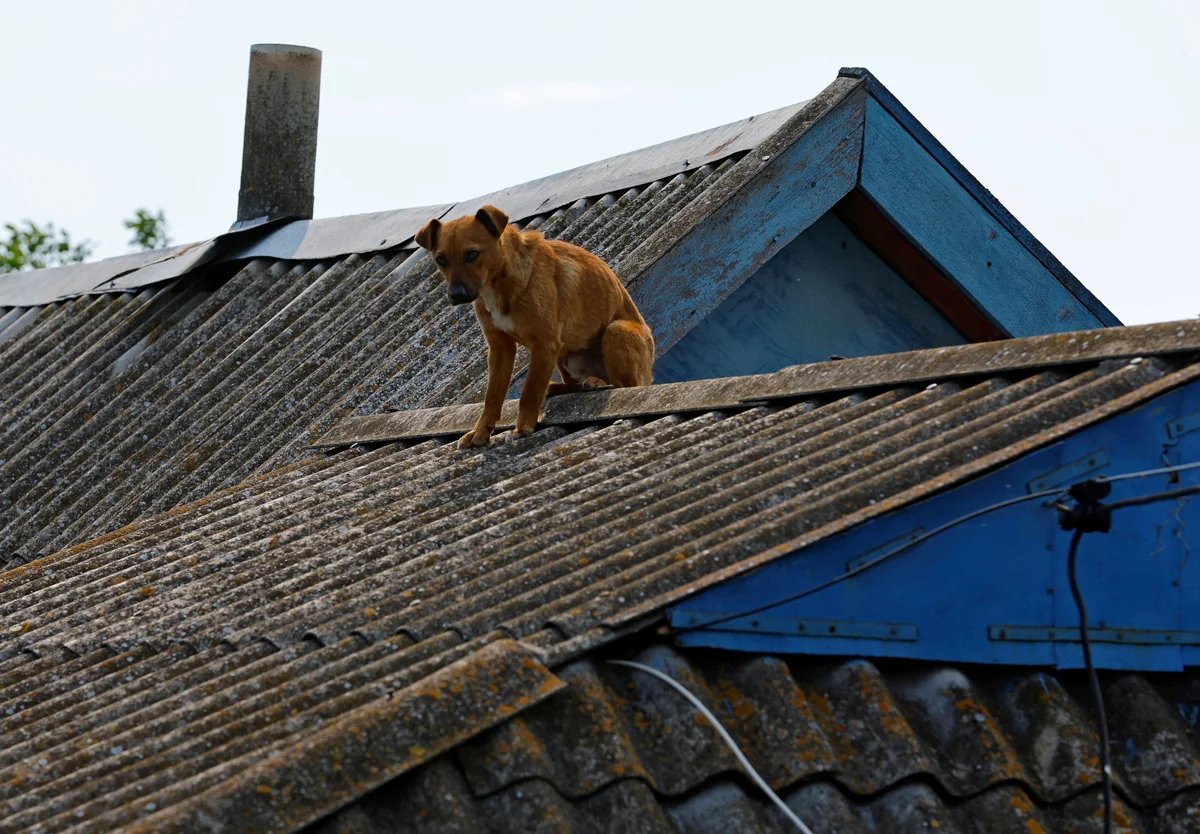
A dog on the roof of a flooded house, Hola Prystan, Kherson region, Ukraine, 8 June 2023. Photo: Alexander Yermochenko / Reuters / Scanpix / LETA
Natasha, 45, occupied Hola Prystan
I understand that there’s little that we can change about our lives now. I haven’t seen my husband in over three years and the signal is so bad that we can’t even make video calls. I joke that our kids have forgotten what he looks like. All our photos were destroyed in the flood and he’s rarely able to send new ones because of the poor connection.
I’m glad that the school year is over and my children were able to finish it successfully. We’re not able to connect to online classes. We’re barely able to download the assignments and do them ourselves.
My kids are still growing. The market where we can buy clothes opens twice a week, but everything sold there is really poor quality. The sneakers there are so bad that the soles don’t even bend. Wearing shoes like that ruins your feet — and they’re not cheap either. So you have to choose between paying for food or shoes.

A boat in a yard after the water had receded, Hola Prystan, Kherson region, Ukraine, 17 June 2023. Photo: Alexander Yermochenko / Reuters / Scanpix / LETA
Now the occupiers want us to pay for gas. Inspectors have started going door-to-door, checking which houses are still inhabited in order to bill the residents. Initially, we were told that those living within the 15-kilometre [combat] zone would be exempt from payments. But that has since been retracted. Now we’re all left wondering why we should be paying for utilities at all.
There are practically no public services left in the city except for electricians and city workers who collect rubbish and clean the streets in a small part of the centre. That’s the area where they occasionally shoot propaganda films showing how much better life is in the “liberated” city and how it’s been rebuilt since the flood. There are even flowerbeds and freshly painted curbs. Meanwhile, two years after the flood, most of the city’s streets are still covered in rubbish.
Lately we haven’t seen the occupiers on the streets. We live parallel lives.
Financially, pensioners are better off since they receive both Russian and Ukrainians pensions. There’s no work for young people in the city. The occupiers say there are plenty of jobs sweeping the streets. I have a university degree, but to them, I’m nothing more than a janitor. I asked around about the working conditions. Turns out that street cleaners only sweep one area in the centre. They risk their lives every day to clear away the glass and rubble from the constant shelling.
Everything in the city that survived the flood is now getting destroyed in daily airstrikes. It’s impossible to look at our city without crying. We could be earning money using the city as a horror movie set. Filmmakers wouldn’t have to spend money on props. We have everything you need for any type of horror. There’s not one building in Hola Prystan that’s still intact.
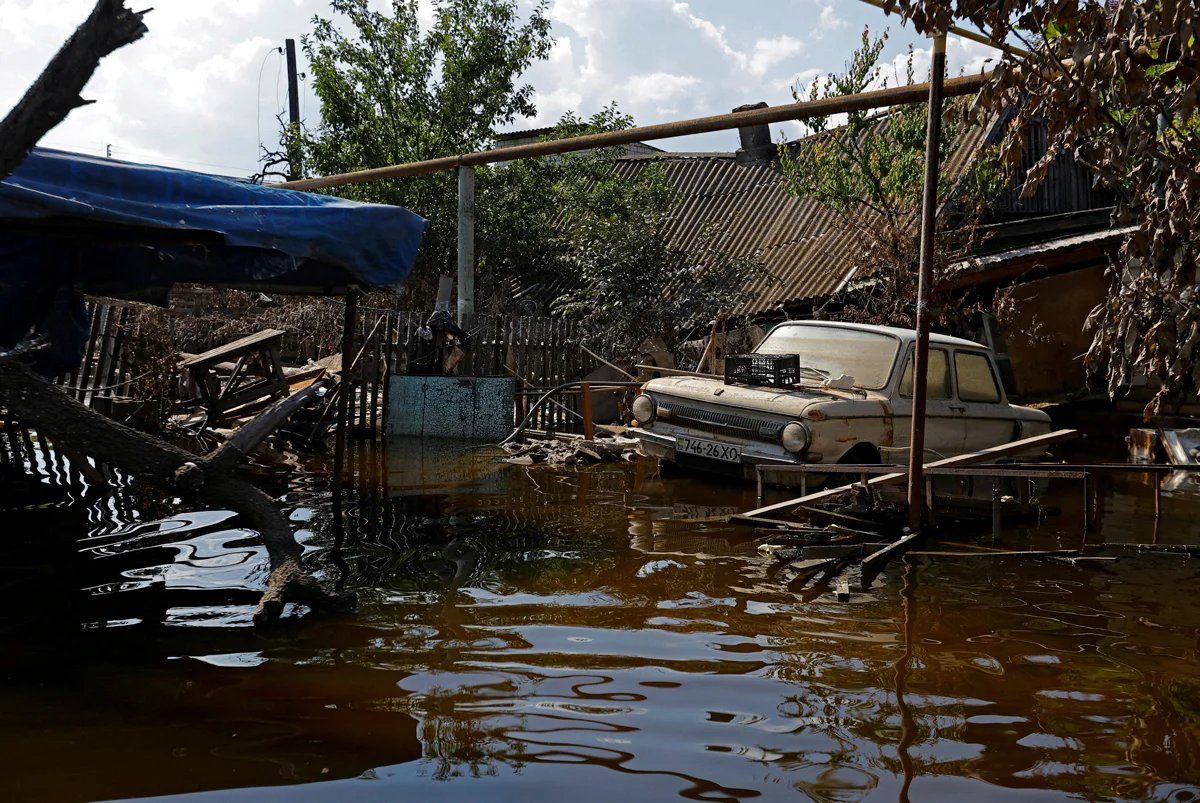
A flooded yard in Hola Prystan, Kherson region, Ukraine, 16 June 2023. Photo: Alexander Yermochenko / Reuters / Scanpix / LETA
Lately we haven’t seen the occupiers on the streets. We live parallel lives. We only go out in the daylight and they only come out at night. We know that they live in abandoned houses. Not long ago, I went back to the house I lived in before the flood. Everything in the property that was more or less intact is now covered in shell fragments. Honestly, I think that the flood actually saved us. We wouldn’t have survived such intense shelling.
When they announced a ceasefire, they continued attacking us, as usual. I have to admit that I’m now scared of holidays because that’s when we get shelled the most. Last New Year’s, I counted 51 strikes in our neighbourhood and the majority were close to my home.
I’m not leaving. I believe you can’t escape fate. I know people who were killed in airstrikes after they moved to Ukrainian-controlled territory and I can’t help but think that they would’ve still been alive had they stayed. The only reason I’d leave is if Hola Prystan ended up officially recognised as Russian territory and Ukraine stopped defending us. As long as I see that the Armed Forces of Ukraine are trying to liberate us, I won’t leave.
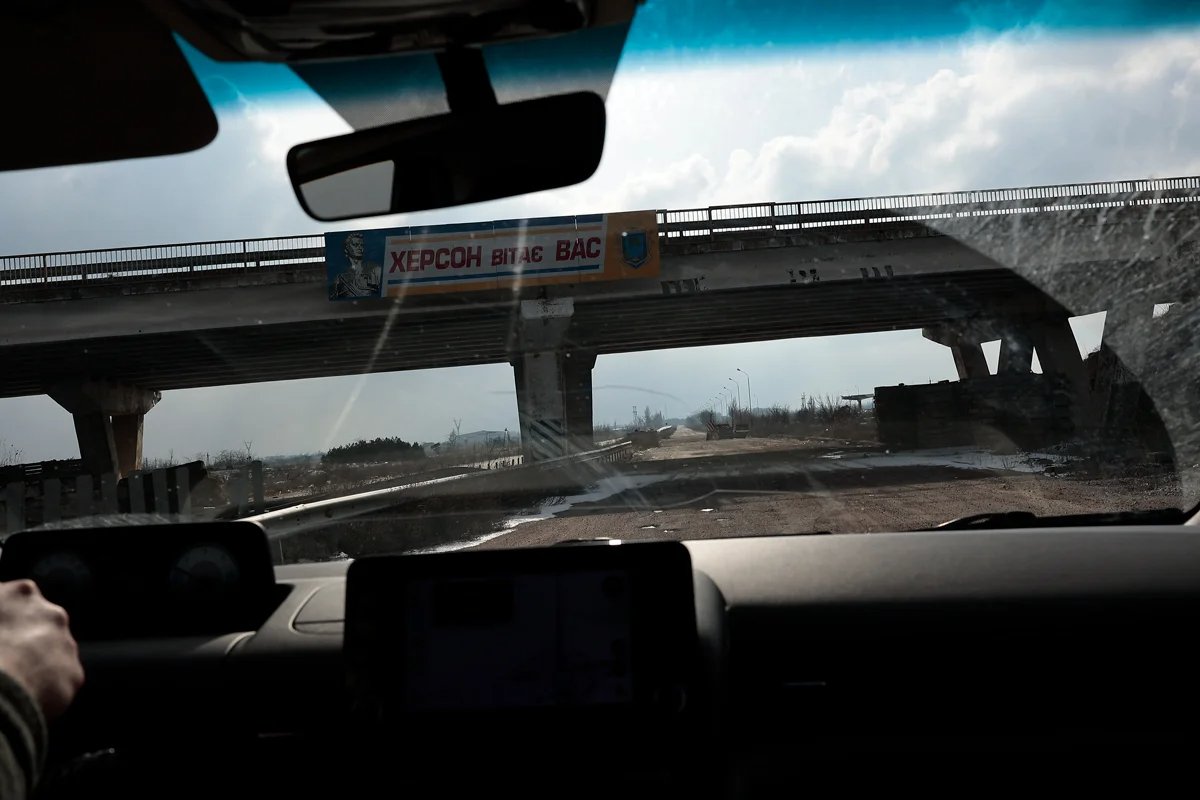
Driving into Kherson, February 2025. Photo: Vasily Krestyaninov / Novaya Gazeta Europe
Vera, 83, occupied Kardashynka, a village five kilometres from Hola Prystan, and Kherson
I dream about returning home to Kardashynka. But I’ll probably end up dying in Kherson.
After the flood, I managed to go back to my house once. There were weapons on my property and Russian soldiers living in a stone house that the flood hadn’t destroyed. But since the enemies have moved in, the Ukrainian army must have bombed my house by now. My neighbour doesn’t know what’s happened to her house either. We call each other and mourn our homes. Recently, I heard that most of the village burnt down after another round of shelling. Maybe the walls [of my house] are still there, at least? Then I could rebuild it.
People are slowly returning to Kherson. Not long ago, I was walking back from the park and counted 103 cars. A year ago, there were far fewer. Our apartment building’s courtyard looks beautiful now. Shells rarely hit it, so my neighbours planted flowers and painted the benches. You can’t live in constant fear, waiting for disaster — life always wins out.
The Russian government has banned independent media. We were forced to leave our country in order to keep doing our job, telling our readers about what is going on Russia, Ukraine and Europe.
We will continue fighting against warfare and dictatorship. We believe that freedom of speech is the most efficient antidote against tyranny. Support us financially to help us fight for peace and freedom.
By clicking the Support button, you agree to the processing of your personal data.
To cancel a regular donation, please write to [email protected]
VPNovaya
Help Russians and Belarusians Access the Truth
